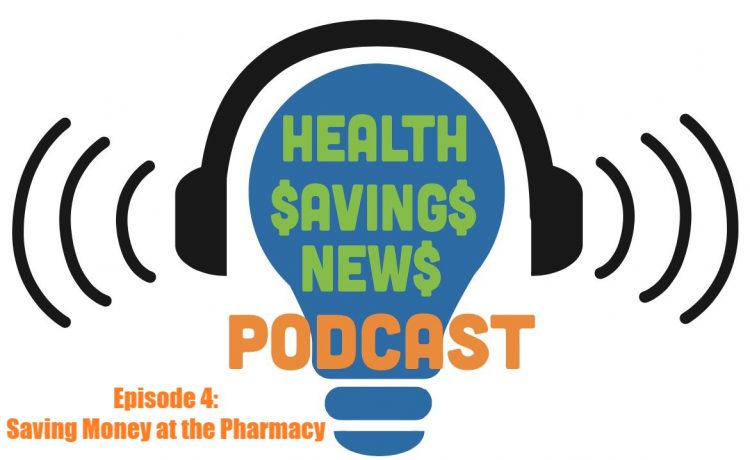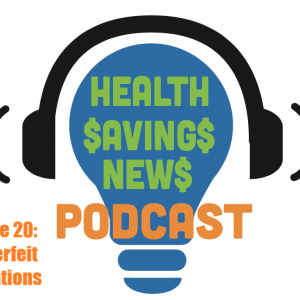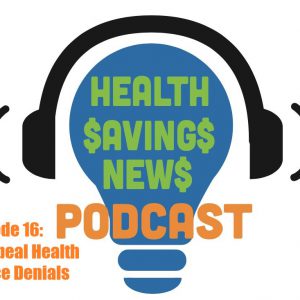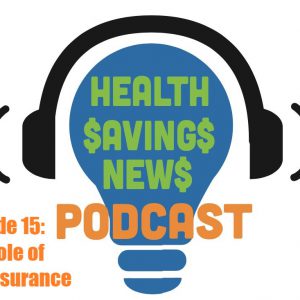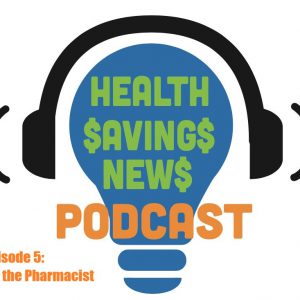This a transcript to episode 4 of Health Savings News. In the interest of making the podcast more accessible, we will post transcripts every two weeks as episodes release.
Evan (00:10):
Hello, and welcome to Health Savings News: the podcast about healthcare costs in America and how to save money on the often expensive care all kinds of people need. I’m your host, Evan O’Connor joined by retired doctors, Rich Sagall and Mike Woods. Each episode we discuss healthcare costs in America, offer tips for saving money, and relevant news that affects and reflects the expensive landscape of healthcare in America. Today’s topic is how to save money at the pharmacy. For the decade I’ve been researching healthcare costs in the United States, I’ve consistently found prescription drug costs to be an important area of public concern. About 60% of adults say they are currently taking at least one prescription medication and a quarter say they’re currently taking four or more. 83% of American adults say the cost of prescription drugs is unreasonable. With all that in mind, we’ve talked about drug costs before and things to ask. Mike, do you wanna go over some questions you’d ask before the prescription is even written?
Mike (01:06):
Yeah. Some of the more important things we’ve already discussed in previous presentations, but the most important is always asking you, is this medication necessary? And to always review all of your current medications with your provider to determine if you still need to be on them. Generic medication should always be the default choice when they’re available. So even though every drug does have a generic name, there are not always generic versions of every drug and many are only available as brand names. You need to make sure your prescriber is prescribing within your insurance’s formulary. And if not, they should be getting prior authorizations for those drugs. Although unfortunately, that doesn’t always mean that your insurance company will pay a significant amount of the cost. It’s important to avoid expensive combination medications or the latest and greatest new drugs that aren’t significantly better than any of the standard treatments on the market, and communicating your financial needs upfront so that your provider is aware ahead of time, that they may be looking for lower cost options for your prescriptions. Some other things that we haven’t mentioned that are very important to discuss with your doctor is when you are requesting medications within your formulary, you should know that the doctor’s electronic health records frequently will connect them to your insurance as formulary and allow an easy lookup to see if this medication is in the formulary. In many cases, your doctor can include a secondary note that says allow for generic substitution so that if there are other generic versions available the pharmacist can go ahead and substitute them without having to check with your doctor again. In some cases there may be a therapeutic substitution, which is a slightly different drug that does exactly the same thing. For example different cholesterol, lowering medications. Some may be less expensive than others, and may be just as effective as the one that the physician wrote for you. Your pharmacist would have to check back with a physician to be able to make that change. One thing that may be less common now, now that the drug companies are more aware of problems associated with it, is asking for samples. So I suspect most providers do have samples in their office, and if you’re starting a new medication this is a great time to ask if the physician has samples that they can give you. A lot of drug companies also have free trial programs that you can contact the manufacturer about. My final recommendation here is — it’s more of a preventive one than anything else — but make sure you tell your physician about any food or drug allergies, because having a reaction to a drug, either a drug interaction with some of the drugs that you’re on or drug allergy can be a very costly proposition if you have a bad reaction.
Evan (04:24):
Great. As Mike and I said, some of those things are new, but a lot we’ve covered a lot of this in previous episodes. Rich, do you wanna go over some of the things you talked to your pharmacist about, like while they’re filling the prescription or before they fill it out?
Rich (04:36):
Sure. One important thing is make sure that the pharmacist knows other medications that you’re taking. Now, if you only use one pharmacy that you’re in the computer system and there’s no problem, but if you sharp around and we’ll discuss that later on, they may not have all of your medications in their system. So you should always make sure they know that. Mike brought up a number of good points. One interesting point is that in many states, the physician has to check off prescribed brand name. Otherwise a pharmacist can go right ahead and do the generic substitution. And we’ve found that the generics work as well as the brand names, they’re just allow less expensive. There are a number of other points to keep in mind once you know, the price of the drug. One is whether it’s better to get a higher dosage of the drug and then split the pills. Sometimes that will save a lot of money. Other times it won’t. Mike mentioned the combination drugs, sometimes splitting ’em into separate drugs is a lot less expensive, but I’ve also found that sometimes taking a combo — particularly if it’s a generic version of a combo — is less expensive than getting both prescriptions separately. So you have to check around and see,
Mike (05:45):
I wanted to make a side comment about cutting pills. It’s not always necessary and the pills have to be the correct consistency to be able to cut. What you save by cutting pills is you usually only save if you have to do one copay so that you can cut your copay in half. If you’re cutting the pills in half. But it’s much more effective if the higher dose is less expensive than the cost of the smaller dose. You should always check with your pharmacist, and in some cases ask them to do it because many pills are too soft and will crumble when you try to split them. There are some that are too hard and will actually fracture when you try to split them. And there are many that have a protective coating on them that you will disrupt when you cut the medication.
Rich (06:36):
Usually if a pill is scored, then it’s safe to cut it. If it’s not scored or it’s a capsule, then you need to talk to the pharmacist as Mike mentioned. It’s interesting that sometimes the cost of the drug is based upon the milligrams of the drug that’s in a pill or a capsule and sometimes it’s just how many tablets you get. So you do wanna make sure that you’re really saving money by getting by splitting the pills.
Evan (07:00):
I just want to note, you definitely want to make sure you’re splitting pills to meet your dose. You don’t want to split pills because you don’t have enough money to afford to pick up the next prescription, because that can be very dangerous. That is non-adherence to medicine. You just wanna be really careful about making sure it’s appropriate to split the pills before doing so.
Rich (07:20):
And that’s good advice, Evan, because if you’re taking half the prescribed dose, you may just be throwing away your money because it’s not doing anything. Another important tip is shopping around. I’ve discovered through the years of working with drug pricing, that the same drug may be hundreds of dollars, different in price from one pharmacy to another. Now there are advantages to shopping around which you do get a cheaper price and you may be saving a significant amount of money. There are disadvantages to shopping around. One is, as I already alluded to, is no one pharmacy knows all the medications you’re taking because you’re using different pharmacies. Another is, it is a lot of work and the prices change from month to month. So pharmacy A may be the cheapest this month and pharmacy B the cheapest next month.
Mike (08:06):
A tool that can actually help you shop around can be found on NeedyMeds, which is a price comparison tool that you can enter your medication and your location, and actually learn about the various prices in the pharmacies in your area. There were a few other ones that you can check that we can include in the transcript on the blog.
Rich (08:32):
The price for comparison tool we should mention are the prices that you get with our drug discount card. Usually the person who pays the most for almost any healthcare service or product is the cash paying patient and the drug discount card, such as ours, only works for people who are taking medications, not covered by their insurance. It does not work with any state of federal programs.
Evan (08:55):
It’s also worth mentioning, as Mike had mentioned earlier, that prices can change monthly in pharmacies. With the NeedyMeds Drug Discount Card, the prices can change daily. So you want to make sure you check the price the day you’re picking it up.
Rich (09:06):
That’s right. Any pricing tool gives you an estimate. We can’t guarantee that’s the price that day.
Mike (09:11):
One of the things that you may be surprised to learn is that the price quoted by your pharmacy isn’t always the bottom line price. There are many things that you can do at your pharmacy that may be able to help you reduce the price. For instance, some pharmacies will offer price matching where if you find the cost of a medication is less expensive than another competitor’s pharmacy, they may offer the matching option and charge the same price — especially if you’re a loyal customer. Sometimes you can actually negotiate discounts with the pharmacy if you’re having trouble paying for it. You can also ask if there’s a pharmacy membership program that will help you save money. This is actually fairly common in some, some of the larger systems such as Costco or Sam’s club, where being on their program can save a considerable amount of money.
Rich (10:06):
Mike had mentioned when starting on a new medication, ask if the doctor has some samples so you don’t get your new prescription filled till you’ve taken the drug for a few days to make sure you have no problems with it. Another option is to ask the pharmacist to give you a partial fill on the prescription. So if the doctor wrote for a 90 day supply, you could ask for five days or a week or 10 days to give it a try and then go back and get the rest. If it’s working. This is another way that you could save on prescription cost by not getting medications it turns out you can’t take.
Mike (10:37):
Yes, and you don’t end up with extra medication that you paid for. And couldn’t take and be reassured that if you get a partial prescription, the copay is partial as well. So you don’t have to worry that you’re gonna have to spend full copay and only get a partial fill.
Rich (10:52):
Now, there are programs available that help people who can’t afford medications. These are called the pharmaceutical Patient Assistance Programs and information on all of those programs is listed on NeedyMeds. These are programs funded by the pharma companies that provide free or very low cost medication to individuals who meet certain eligibility requirements which are generally based upon income, insurance status, residency, and diagnosis. As I mentioned, NeedyMeds, all these programs are listed on our website and they are saving people billions of dollars every year. So if you feel you may qualify for one of these programs and you’re on a brand name medication, you should check it out.
Mike (11:32):
Yeah. There is also programs that are specific for certain chronic and complex medical conditions that can also be found on the NeedyMeds website.
Rich (11:43):
I wanna mention that the Patient Assistance Programs are not strictly for people who have low incomes. Many of the programs will help people who are 600, 700, 800% of the federal poverty level. That would mean a family of four with no health insurance or no medication coverage making $80-90,000 might qualify for a program. So it pays to check the programs and see if you might qualify for one.
Mike (12:09):
There are other ways that you can think about saving on medication costs is to realize that not all forms of a medication are equal in cost. For example, sometimes the pill form of a medication is more expensive than the capsule form and sometimes it’s the other way around. So it’s worth asking. Injectable medications are much more expensive if you buy pre-filled syringes. So if you can manage to buy a vial and use the vial that there’s a much less expensive option.
Rich (12:43):
Another option is looking to see if the drug is available over the counter. I know from when I started practice many years ago, a number of drugs that were prescription only have now gone to over the counter. The medication is the same, but the dosage may be less. Sometimes the over the counter is less expensive and sometimes because of a low copay, getting a prescription for an over the counter medicine would save you money. So it’s worth checking, particularly if you’re gonna be on something chronically.
Mike (13:10):
Yeah, there are some subtle details you need to pay attention to, however. Even though you look at an over the counter drug may appear less expensive for dose, you have to realize that in most cases the amount of the medication in the pill is actually less than the prescription form and you’d need to end up taking multiple pills or capsules to get the same overall result treatment wise. Also, when you buy over the counter containers, they come with a specific number of pills that may or may not correspond to how many pills you need for your entire treatment course. So for instance, if you’re on a medication twice a day for two weeks, your prescription would have 28 pills in it. You might find that if you get the over the counter form, there’s only 20 pills that would require you to buy an extra bottle of pills to finish the treatment and you’d end up paying for 12 pills you didn’t need. And remember, when you’re looking at an over the counter cost, you need to compare it with the copay and not the overall price of the medication. And finally, you should check with your provider to make sure you have the condition you’re trying to treat otherwise you’re wasting your money. So that’s a very common waste of money at the pharmacy is treating conditions that you don’t really have, but thought you did cuz you used Dr. Google. Another way that you can save money is requesting a 90 day prescription if your insurance company will allow it. A lot of times, when you buy a 90 day prescription, you do get a volume discount. All of that does depend on the pharmacy and retailer. It may be related to the tier or overall cost of the drugs if they offer these volume discounts. But the other thing is that most insurance companies will allow you to save money by only charging you two month copays rather than the three months of copays that you would’ve done if you had not bought it on a 90 day prescription. Not only that you’ll end up going to the pharmacy less and spend less money doing that.
Rich (15:22):
NeedyMeds lists other programs besides the Patient Assistance Programs that may save you money. We have a section called copay coupons and rebates, and there are many copay cards that will help cover the cost of your copayment for a medication. Even if you have insurance, it’s worth checking those out. Most of those programs are not based upon any financial situation or status, so you could save quite a bit of money with those.
Mike (15:46):
Pharmacies also offer coupons as well. So take advantage of those if they do.
Rich (15:52):
Another source of savings on the NeedyMeds website is the Diagnosis Based Assistance section. Here, we list programs that help people based upon their diagnosis, not specifically on their medication. Many of these programs do help with medication costs or other types of costs that you may experience due to your illness. We also have a number of programs that help people who are suffering from COVID or Long COVID. That’s another section worth checking out.
Mike (16:20):
Sometimes you wanna look outside of the pharmacy option and realize that there are other ways to get your medication other than pharmacies. One of those is mail order prescription drugs. Most of the time mail order can save up to 10 to 30% off brand aid medications. The problem with online pharmacies is you have to scrutinize them very closely before you use them. So there are a lot of things that you should do then the first is to search the VIPPPs Accredited Pharmacy Database from the National Association Board for Pharmacies that will tell you which of these online pharmacies are accredited. The FDA also has a website page called Quick Tips for Buying Medicines Over the Internet that can also tell you if this is a credible business. Really beware of pharmacies that don’t require prescriptions, don’t give you any contact info, you can’t find any proper licensing or certification, and be leery of foreign pharmacies because not all countries have the quality control standards that the United States has. And finally, when you’re taking into account mail over to pharmacies, don’t forget to include the price of shipping in your costs unless the pharmacy includes that is part of your service.
Rich (17:57):
Now I want to give an example of how complex things can be. Let’s suppose you’re taking a non-steroidal antiinflammatory — an NSAID — for arthritis. You can get it by prescription; you can get it over the counter. There are multiple different over the counter medications that are all NSAIDs. If you were to be taking ibuprofen or Motrin, it comes multiple different strengths and you’d have to find out which is cheaper. If you were taking 600 milligrams four times a day, which is a standard dose, and it seems to be working, are you better off taking two 400 that are over the counter or one 800 that’s by prescription? Maybe you find that it doesn’t last long enough and you should be taking 600 milligrams four times a day. Or if it’s lasting, you could take 800 milligrams three times a day. Again, the pricing can vary quite a bit. As Mike had mentioned earlier, one NSAID may not work, but another one would work for you. So you may have to try different NSAID to see which is the best for you.
Mike (18:59):
When it comes to over the counter medications, the way you can save the most money at the pharmacy is to do your research into the effectiveness of what you’re gonna buy. A significant percentage of over the counter products — and that includes supplements and many of the medications — really don’t work. So for example, over the counter medications for colds: there’s really no evidence that they have any significant effectiveness. And there are in fact studies that show that some of them make things worse. As a pediatrician, one of the things that I would have trouble convincing my parents is that you don’t have to bring your child’s temperature down to normal when they’re sick. Bacteria and viruses do not thrive as well at high temperatures. So when you aggressively manage your fever and bring your temperature back to normal, you’re actually providing an environment that allow the bacteria and viruses to stay in your body longer. I also have a statement that I like to mention is that Americans have the most expensive urine in the world. This is a result of taking multivitamins, minerals, and supplements that get quickly eliminated in the urine because your body doesn’t need them. For most of this stuff, eating a nutritional diet is more than adequate to provide the needs of multivitamins, minerals, and supplements. As a matter of fact, there are only a few vitamins or supplements that are actually shown to be very useful. One is folic acid before pregnancy and another is vitamin D in areas where there is low sun exposure. Everything else is debatable, whether or not it would work. And for the most part, you’re gonna find if you do the research that it actually doesn’t.
Rich (20:59):
Going back to Mike’s example of treating a fever. I used to tell parents if the fever bothers the child, then you should treat it. If the fever bothers you, then you take the medicine, not the child.
<Laugh>
Mike (21:13):
Very good advice.
Evan (21:15):
The Centers for Medicare and Medicaid Services report that the United States spent over $348 billion on prescription medications in 2020. Over the counter drugs cost Americans $36.5 billion that same year, like we’ve been saying, these prices can add up very quickly when it’s seen on a national scale like this.
[segment break]
The last segment of each episode, we suggest some of the culture, art, entertainment, and social causes we’ve been engaged with to each other and our listeners.
Rich (21:45):
I’d like to talk about one of my favorite websites. It’s a scary website. It’s called the Partnership for Safe Medicines and the URL is www.safemedicines.org. There they talk about the problems of fake medicines. On this website they cover many different topics. One of which is fake medicines that get into the drug stream or people purchase when they use mail order pharmacies that don’t meet the requirements that Mike mentioned. It’s really quite scary to see how much fentanyl and other drugs are getting into this country illegally and getting into the drug stream. We have a system called tag and track for medications. It’s supposed to follow medications from the manufacturer through the whole wholesale and retail stream to the patient. But even with that very tight system, which is among the best in the world, counterfeit drugs get in and pharmacists, or sometimes even physicians will purchase them and use them whether, and they may know or not know whether the drug is real. So it’s a worthwhile website to check out. They have many short videos talking about what’s going on. Again, it’s a Partnership for Safe Medicines, www.safemedicines.org.
Evan (23:03):
This week I got a podcast. It’s a new podcast from STAT News, which is a healthcare related publication that I use a lot. It’s Color Code. It’s hosted by science reporter Nicholas St. Fleur, and is about racial inequities in American healthcare, the history of racism in the U.S. healthcare system, and how it continues to impact people of color and underserved communities. The episodes are short, they’re about 30 minutes. By the time this episode comes out, they should be wrapping up their eight episodes series but I’ve found the episodes I’ve listened to have been really interesting and valuable.
Thank you so much for joining us for this episode of Health Savings News, please subscribe, rate, and review us on Apple Podcast or wherever you’re listening to the show, it really does help. You can follow @NeedyMeds on Twitter, Facebook, Instagram, LinkedIn, YouTube, and you can follow @HealthSavingPod (no S at the end of saving) on Twitter for updates specific to this podcast and send questions, comments, and topic suggestions to podcast@needymeds.org. Our music is composed by Samuel Rulon Miller. His music can be found at musicisadirtyword.bandcamp.com. Health Savings News podcast is produced by me, Evan O’Connor. All the sources we used in our research can be found in the episode’s podcast description on our website or your podcast app of choice. Health Savings News is not intended to substitute for professional medical, financial or legal advice. Always seek the advice of qualified healthcare, professional, or appropriate professional with any questions use express and Health Savings News are solely those as the individuals expressing them. Any views expressed do not necessarily represent views in health savings, news, other contributors to organization or staff. Thanks again for listening. See you in two weeks with our next episode.
Sources:
https://www.needymeds.org/coupons-branch
https://www.kff.org/health-costs/poll-finding/public-opinion-on-prescription-drugs-and-their-prices
https://www.statista.com/statistics/184914/prescription-drug-expenditures-in-the-us-since-1960/
https://www.statista.com/statistics/307237/otc-sales-in-theus/
https://www.turningclockback.com/save-money-at-the-pharmacy/
https://www.verywellhealth.com/free-low-cost-prescription-drugs-stores-2615299
https://www.consumerreports.org/drugs/is-it-safe-to-split-pills-in-half/
https://considerable.com/5-pharmacist-questions/
https://nabp.pharmacy/programs/vipps/vipps-accredited-pharmacies-list/
https://www.fda.gov/drugs/buying-using-medicine-safely/quick-tips-buying-medicines-over-internet
https://www.consumerreports.org/drug-prices/shop-around-for-better-drug-prices/
https://www.lifesavvy.com/20534/want-to-save-on-otc-medication-ask-your-doctor-for-a-prescription/

